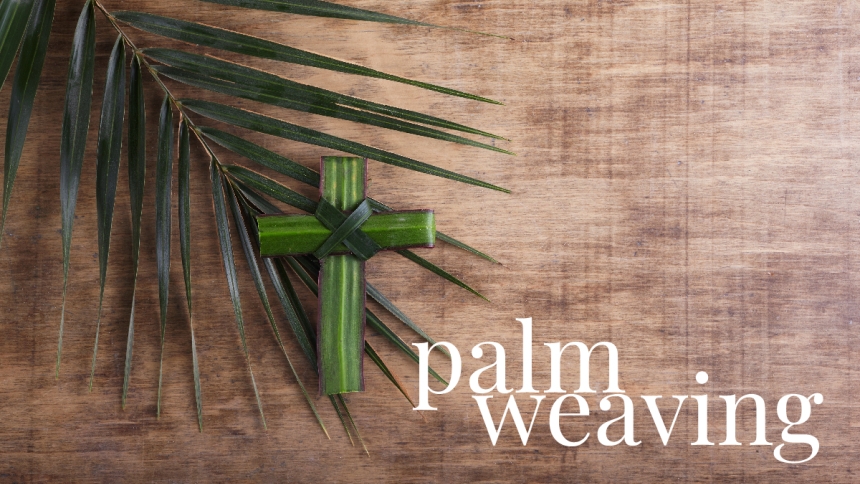
What do you do with the fronds you bring home from Palm Sunday Mass?
Place them on a dresser or tuck them behind a crucifix, perhaps? This year, why not try something different, something more creative? Take a page out of Sr. Cecilia Schmitt`s book - literally.
Sr. Cecilia, a Franciscan nun living in St. Cloud, Minn., has self published a book called Palm Weaving: The Story and the Art. Within its pages are more than 100 palm-weaving patterns from around the world.
Crosses - both simple and ornate - are included in the book. So are more elaborate patterns, including flowers, butterflies, birds, stars, fish, frames for holy pictures, and crowns of thorns.
What is the origin of the practice of palm weaving for religious purposes? Sr. Cecilia`s research has led her to suggest Sicily as the starting point. But much of Europe now considers it an established Easter tradition. One German custom involves not only the weaving of crosses but the burying of them in farmers` fields to ensure God`s blessings.
Palm weaving is also part of many tropical cultures, where it is practiced along side basket weaving.
To make a weaving of your own, start by picking fresh, flexible, green fronds. (Store them in a refrigerator if you can`t work with them right away.) No special tools are required, just your hands and the occasional pin or paper clip to secure a design until the frond dries.
Woven fronds will take on the color of straw as they age, and may be displayed for years with just an occasional dusting. Depending on the pattern you choose, the fronds can be hung from a ribbon, arranged in a bouquet, or left to sit out on a bookcase or tabletop.
Here`s a simple cross pattern to get you started on this craft. Even children will find this one easy and rewarding; why not adopt it as a fun family activity during Holy Week? Following that is a pinecone pattern, for our more adventurous readers!
Cross pattern
- Take a palm frond about one inch wide and 13 inches long. Hold it horizontally.
- Bend the right end straight up from the center to form a right angle.
- Fold this same top strip, from the center, back and down, up and over again, to form a square at the back. It will still be a right angle at this point.
- Bring the left strip forward and fold over the center toward the right. Fold away from you and thread through the square at the back, all the way.
- Bend the top strip forward and thread the end through the center square to make a shaft of desired length.
- Fold left strip backward and thread through the back square. This makes the left crossbar and should be in proportion to the shaft.
- Fold the right strip back to form the right crossbar and thread through the back square to secure. Cut a `V` into the base of the shaft for a dovetail effect, if desired. The finished cross should measure approximately 2 inches wide by 3 inches high.
Pinecone pattern
- Find a palm that has four strands or gather four individual strands and staple them together at the base. Choose palms that have tapered ends to make a more natural-looking pinecone that narrows at the top.
- Hold the connected strands in one hand. Use the other hand to bend one strand away from you (pointing north), another strand over this and to the left (pointing west), and another strand over this toward you (pointing south). The last strand should be placed over the third and under the first (pointing east). You should now have a strand going in each direction and a square platform from which to start weaving.
- Pull the platform tight and continue to fold the strands in four directions, tucking the fourth strand under the first each time to secure your work. You will weave clockwise, then counterclockwise, beginning with any strand. Watch that your weaving stays even and the tightness of the weave consistent.
- As you approach the end of the strands, you can pull them together to tie off or tuck them in under a previous loop. Put a straight pin in to secure the closure, removing the pin when the palm is dry. The finished pinecone will vary in size, depending on the length of the strands.
The base may be decorated with ribbon and a sprig of dried flowers.
When Palms Are in Short Supply In the countries of northern Europe, it is common to celebrate Palm Sunday not with palms but with pussy willows, which grow commonly throughout the region. In Poland, for instance, boys lightly swat the girls with willow switches on Switching Day, celebrating the end of Lent, and girls return the favor on Easter Tuesday. Crosses are made of cattails and hung over the main entry of the house. Dipped in holy water, they are also used to bless farm animals.






